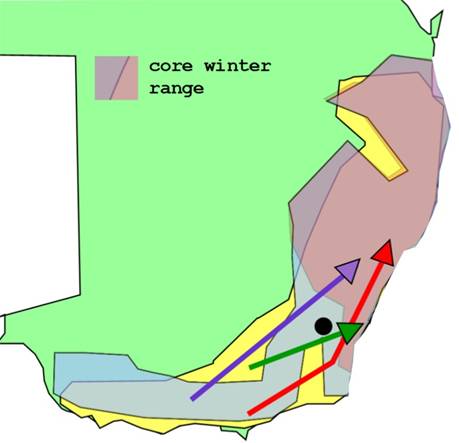How little we know about this process. Is an
observed movement a swirl or back-eddy, and do the movers just relocate
themselves a couple of hundred kms or so, or leap-frog other populations.
There are quite a few overwinterers in Victoria. Perhaps there is a fair
bit of food-motivated nomadism; they like mistletoe and there is a bit in
flower at the moment around here. It is difficult to translate the
collated observations in the atlas into numbers of birds, but the main pattern
seems to be that part of the Victorian population moves north-west, the
Canberra area being a narrow point in the funnel. The below is regrettably
crude, but based on the atlas maps of main concentrations of the contiguous
population for 'Summer' (15 Dec - 15 Feb) (yellow) and ‘Winter’ (15
June – 15 August) (pale blue).

The apparent main winter concentration is shown by an
overlay on the pale blue. The scattered obs in central Q (mainly Spring and Winter) are left out. Arrows indicate
possible directions of movement near Canberra. Of course the clean lines
should be much more blurred.
-----Original Message-----
From: Ian Fraser [
Sent: Saturday, 1 March 2008 11:51 AM
To: Cog line
Subject: Yellow-faced Honeyeaters - why early?
Perhaps what we're seeing is, rather than the start of
the true
migration to the north, simply an early movement down out
of the ranges,
where things must have been more than a bit nippy for Feb
in recent nights?
We should be able to get some idea if that's the case
over the next few
weeks.
IF
--
Ian Fraser,
Environment Tours; Vertego Environmental Wordsmithing
GPO Box 3268, Canberra, ACT 2601
ph: 61 2 6249 1560 fax: 61 2 6247 3227
---
*******************************************************************************************************
This is the email announcement and discussion list of the
Canberra Ornithologists Group.
List-Post:
<>
List-Help:
<>
List-Unsubscribe:
<>
List-Subscribe: <>
List archive:
<http://bioacoustics.cse.unsw.edu.au/archives/html/canberrabirds>
List manager: David McDonald, email
<>

